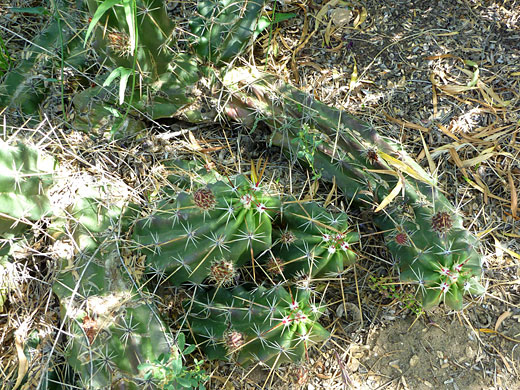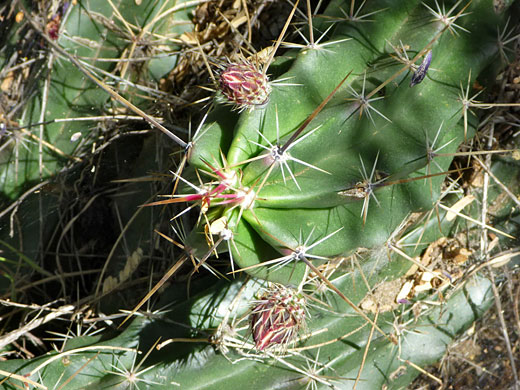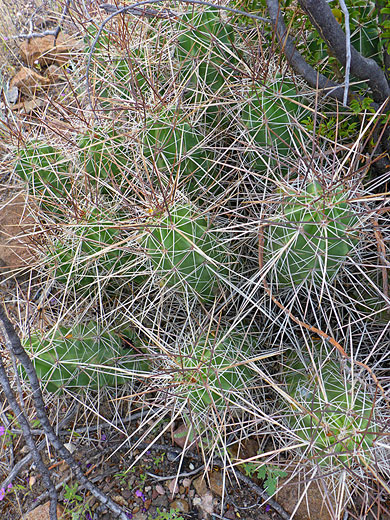Scientific name:
Echinocereus enneacanthus
Common name:
Green strawberry hedgehog cactus, pitaya
Range:
West and south Texas, in the Chihuahuan Desert close to the Rio Grande, especially in Big Bend National Park. Also found in Dona Ana county, south New Mexico
Form:
Large clusters of dozens of individual stems
Habitat:
Low elevations, open areas, scrubland; rocky, gravely or sandy
Flowers:
Pink or magenta, up to 4 inches in diameter, blooming from March to May

Distribution map for echinocereus enneacanthus
This Texan species of hedgehog cactus forms extensive clumps of large stems (each up to 12 inches tall and 5.5 inches in diameter), covered by long, yellow/white spines, which vary in density. Often the stems of echinocereus enneacanthus lie partly flat against the ground, rising upwards at the ends, and are usually dark green in color, becoming yellowish in areas of strong sunlight. Plants may form clusters of several hundred stems.
There are between six and 15 spines per areole - usually five to ten radial, around 1.5 inches long, and one to four central, up to 3.3 inches. Flowers, up to 3 inches across, have rich pink tepals, yellow anthers on thin, pale yellow filaments, and green stigma lobes. The lightly spined, greenish brown fruits which follow the flowers have a taste similar to a strawberry so are often eaten, especially in Mexico, where they are known as pitaya.
Two varieties of echinocereus enneacanthus are recognized. Var enneacanthus grows close to the Rio Grande in the west, extending into far south New Mexico, and forms large, sprawling clusters of densely-spined stems, relatively wide (up to 5.5 inches), with five to eight radial spines per areole. Var brevispinus, exclusive to Texas (east of Big Bend), forms more open clusters, of thinner stems, less than 2 inches across, bearing a lighter covering of spines, with eight to ten radials per areole.
There are between six and 15 spines per areole - usually five to ten radial, around 1.5 inches long, and one to four central, up to 3.3 inches. Flowers, up to 3 inches across, have rich pink tepals, yellow anthers on thin, pale yellow filaments, and green stigma lobes. The lightly spined, greenish brown fruits which follow the flowers have a taste similar to a strawberry so are often eaten, especially in Mexico, where they are known as pitaya.
Two varieties of echinocereus enneacanthus are recognized. Var enneacanthus grows close to the Rio Grande in the west, extending into far south New Mexico, and forms large, sprawling clusters of densely-spined stems, relatively wide (up to 5.5 inches), with five to eight radial spines per areole. Var brevispinus, exclusive to Texas (east of Big Bend), forms more open clusters, of thinner stems, less than 2 inches across, bearing a lighter covering of spines, with eight to ten radials per areole.
All Contents © Copyright The American Southwest | Comments and Questions | Contribute | Affiliate Marketing Disclosure | Site Map





